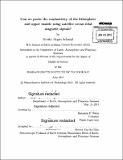Can we probe the conductivity of the lithosphere and upper mantle using satellite ocean tidal magnetic signals?
Author(s)
Schnepf, Neesha Regmi
DownloadFull printable version (8.526Mb)
Alternative title
Sensing the upper mantle and lithosphere using ocean tidal magnetic field satellite measurement
Other Contributors
Massachusetts Institute of Technology. Department of Earth, Atmospheric, and Planetary Sciences.
Advisor
Benjamin P. Weiss.
Terms of use
Metadata
Show full item recordAbstract
The 20 th century brought many breakthroughs in our understanding of Earth, but there are still many outstanding geophysical questions. Deep electromagnetic studies provide information on electrical conductivity from the near-surface to deep within the mantle (~1600 km) complementing seismic work aiming understand the composition, structure and dynamics of the mantle. Electromagnetic induction studies utilize the skin depth concept which relates the period of a source electromagnetic field and the conductivity of the penetrated material with the maximum depth the field can penetrate. Traditional satellite-based induction studies use signals of magnetospheric origin and considered a period range between a few days and a few months. These traditional studies are mostly sensitive to deep conducting structures because of the inductive coupling between primary and induced sources. In contrast, galvanic coupling from the oceanic tidal signal allows for studying less conductive, shallower structures by also using shorter periods. A few studies convincingly demonstrated that the magnetic fields induced by the lunar semidiurnal ocean tide can be identified in satellite observations. This result encourages using tidal satellite magnetic data to constrain subsurface electrical conductivity in oceanic regions. We perform global 3- D electromagnetic numerical simulations to investigate the sensitivity of the ocean's tidal signals magnetic amplitudes to conductivity distributions at different depths. The results of our sensitivity analysis suggest it will be promising to use oceanic signals detected at satellite altitude for probing lithospheric and upper mantle conductivity. Our simulations also suggest that seafloor electric and magnetic field data may provide complementary details to better constrain lithospheric conductivity.
Description
Thesis: S.M., Massachusetts Institute of Technology, Department of Earth, Atmospheric, and Planetary Sciences, 2015. Cataloged from PDF version of thesis. Includes bibliographical references.
Date issued
2015Department
Massachusetts Institute of Technology. Department of Earth, Atmospheric, and Planetary SciencesPublisher
Massachusetts Institute of Technology
Keywords
Earth, Atmospheric, and Planetary Sciences.